#san carlo alle quattro fontane
Text

561x960 Church of San Carlo alle Quattro Fontane, Rome. It's a masterpiece of the Italian Baroque.
28 notes
·
View notes
Text


Stairwell of the crypt of San Carlino 3/13/24
#art#my art#drawing#sketch#drawing from life#pencil sketch#pencil drawing#Chiesa di San Carlino alle Quattro Fontane#san carlino#baroque#borromini#francesco borrimini#barberini#san carlo#church#stairs#architecture#art history#crypt
1 note
·
View note
Photo

San Carlo alle Quattro Fontane, Francesco Borromini, 1646
68 notes
·
View notes
Text


Roman Baroque
San Carlo alle quattro fontane
Rome, 1644
7 notes
·
View notes
Text
Francesco Borromini e Guarino Guarini / Roma e Torino

[*] Francesco Borromini, veduta della cupola di Sant'Ivo alla Sapienza - Roma (1642-1660)

[*] F. Borromini, San Carlo alle Quattro Fontane (1634-67) Roma. Veduta della cupola con i pennacchi

[*] Guarino Guarini, cupola cappella della Sindone (1668-1694)

[*] dettaglio

[*] G. Guarini, cupola chiesa di San Lorenzo - Torino (1668-1680)
https://i-incendium.tumblr.com/ [ foto di Alessio Gioana]
https://www.artesvelata.it/san-carlo-quattro-fontane-borromini/
https://museireali.beniculturali.it/cappella-della-sacra-sindone/
https://italics.art/tip/gli-affreschi-segreti-della-real-chiesa-di-san-lorenzo-a-torino/
6 notes
·
View notes
Text
La Roma de Bernini y Borromini
La Roma del siglo XVII fue un período de gran florecimiento artístico y arquitectónico, y tanto Borromini como Bernini fueron figuras importantes en la creación de la arquitectura barroca en la ciudad. Sus obras son consideradas como algunas de las más impresionantes y bellas de la época.
Borromini es conocido por su estilo arquitectónico distintivo, que se caracteriza por el uso de formas curvas y la manipulación de la luz y la sombra para crear efectos dramáticos. Entre sus obras más famosas se encuentran la iglesia de San Carlo alle Quattro Fontane y la iglesia de Sant'Ivo alla Sapienza.
Por su parte, Bernini es reconocido por sus esculturas y monumentos, así como por sus trabajos arquitectónicos, como la Piazza Navona y la iglesia de Sant'Andrea al Quirinale. También es conocido por su trabajo en la Basílica de San Pedro, donde diseñó la famosa plaza y la famosa baldachin sobre el altar mayor.
En general, la obra de Borromini y Bernini representa una fusión única de la arquitectura, la escultura y el diseño urbano, y su legado continúa siendo una fuente de inspiración para arquitectos y artistas en todo el mundo.
Algunas de las obras de ellos fueron:
Chiesa di Santa Bibiana:
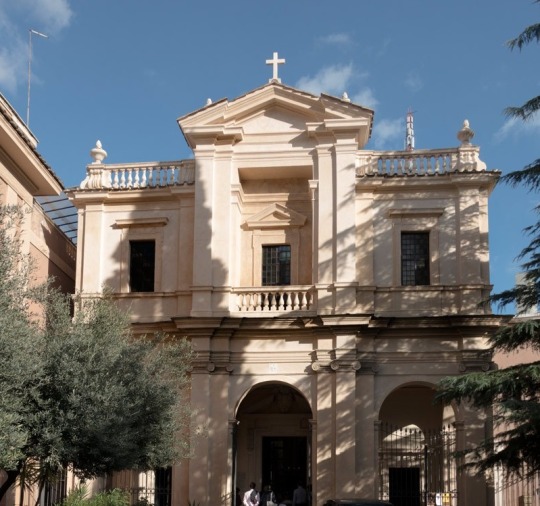
Iglesia de San Carlo alle Quattro Fontane:
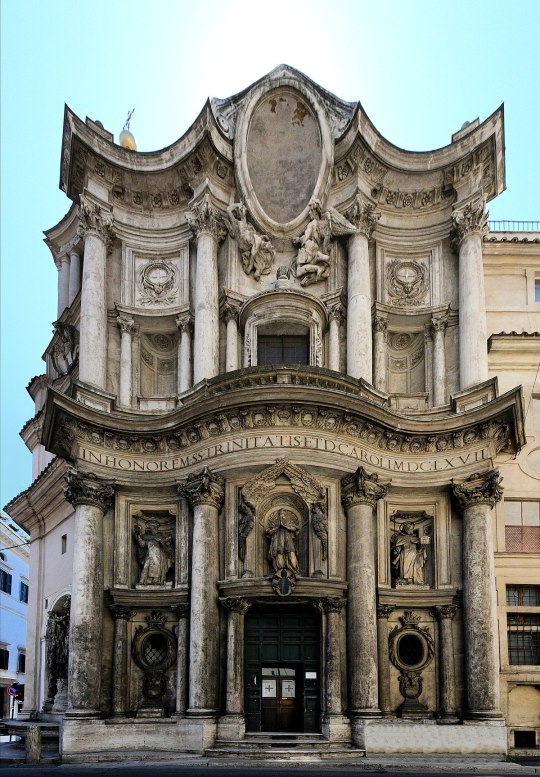
Oratorio dei Filippini:

Sant'ivo Alla Sapienza:

Iglesia de Santa María de la Victoria:

Galería Spada:

Iglesia de San Andrés del Quirinal:

Regia:

Basílica de San Pedro:
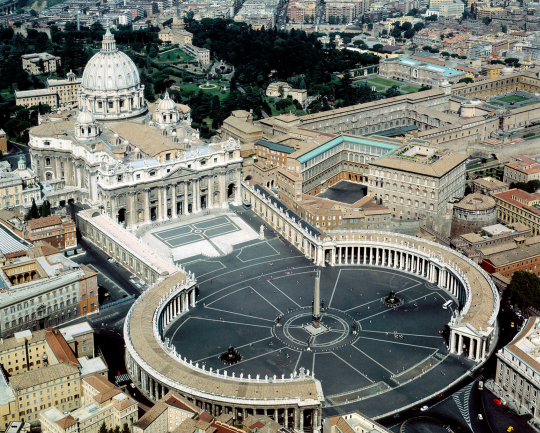
A continuación se presenta una ficha del mapa con una ubicación de las obras más destacadas:
@lonuevodenuevo
10 notes
·
View notes
Text

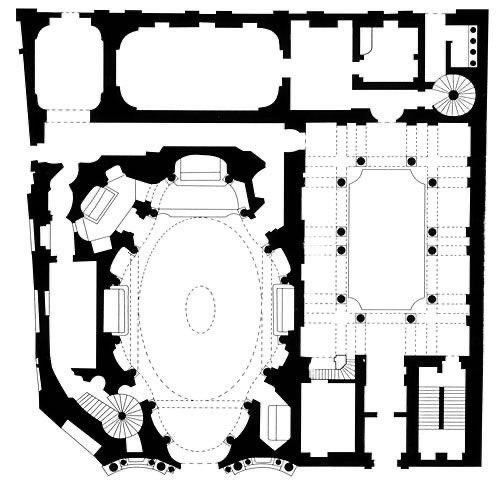

san carlo alle quattro fontane (1667)
#baroque#italy#rome#architecture#coquette#aesthetic#francesco#borromini#francesco borromini#old architecture#pretty#quotes#17th century#1700s#1700s art#art history#art
2 notes
·
View notes
Note
OMG thank you I’m just so overwhelmed because there’s so much to see and eat and do in Italy.
Like I can’t even make it to Florence cinque tere or Venice on this trip.
I would loveeeee specific recs for Rome😭
ugh I know I feel like I could live a whole year in Italy and still wouldn't be enough
museums in Rome I recommend:
for Roman/ancient stuff: Trajan's Market, Baths of Diocletian/Caracalla, Palazzo Massimo,
for Modern stuff: Museum of Modern Art and the MAXXI, Palazzo Barberini
just beautiful architecture: Villa Farnesina, Tempietto, Chiostro di Bramante
Churches: Basilica of St. Lateran, Santa Maria Maggiore, San Carlo alle Quattro Fontane, Basilica di Santo Stefano Rotondo
for shopping the area around Piazza del Popolo is really good, but the restaurants there a bit pricier. If you go to St. Peter's and you exit the square along the main road and you keep going straight and cross the piazza there's some really nice restaurants there and this tiramisu place tucked in a corner that is divineeee.
#most of the food recs I have are close to the vatican bc that's where I stayed but it doesn't make sense for you to trek across town for it#u know#like there's good food everywhere really
1 note
·
View note
Note
Hi Lavi! I’ve just arrived in Rome for a 3 month stay! First time here so I was hoping for some local advice on things to do/see/eat :) any tips will be appreciated! P.S the ask function on the web version seems to be broken :/
hello anon! first of all sorry for replying so late yesterday I got home at like eleven something and I conked out X_X and thanks for the heads up wrt the ask, it's weird because on my web it works but I'll do a double check
that said WELCOME TO ROME I HOPE YOU DON'T END UP LOATHING YOUR STAY THANKS TO HORRID PUBLIC TRANSPORT, that said let me check because I think I had a tag exactly for stuff to do/see in rome let me see if I can give you a round up
eating advice
basic italian + advice on where to go
anyway I realized half of the posts in that tag are in italian so I'll just go at it again at random (and if you ever need advice or anything feel free to ask :D)
if you're here for three months you can take it easy and see all the stuff I mentioned in the second post with all the time in the world, also the vatican museums are free on the last sunday of the month so if you want to wake up early and brave the crowd you can save a bunch of money ;)
that said in between than the usuals - the center with coliseum/roman forum/trevi fountain/piazza del popolo/piazza venezia/campo dei fiori/piazza navona route - there's the free caravaggio paintings in the churches that I always recommend seeing asap - two are in santa maria del popolo (in piazza del popolo), three are in san luigi dei francesi (behind piazza navona), one is in sant'agostino (also near piazza navona)
also going by sculptors not counting of course sant'agnese in piazza navona (borromini) with the bernini fountain in front of it, there's san carlo alle quattro fontane (borromini) which has weird opening times but it's 100% worth visiting - that one is nearer termini station at the quattro fontane street crossing, and on the way there's also santa maria della vittoria near termini where not many ppl know there's bernini's ecstasy of st. theresa (idk every time I bring people there without telling them what it is they all go !!! omg !! XD)
always talking churches, ofc you're gonna visit st. peter's at some point (count that after covid they made it kind of harder to go in so get ready to queue), concerning basilicas I'm more partial to st. paul (there's a convenient metro station thankfully), santa maria maggiore (behind termini station) and san giovanni (there's a metro station), and in the san giovanni area (which is like in the middle of termini/coliseum) there's also san clemente which has protochristian catacombs and tunnels and is very cool to visit
talking about protochristian basilicas, sant'agnese and santa costanza are a bit out of the way but they're the earliest we have and very much worth visiting
musei capitolini are a must for archeological stuff and the roman museum next to termini is a must for ancient rome (there's also the terme di diocleziano in front of termini which are also cool)
for less commonly visited museums, centrale montemartini is v. cool because it's a former factory that houses roman artifacts
always close to termini there's rione monti which has santa prassede (lovely church with ancient mosaics) and a lot of second-hand shops/nice places to eat/have brunch
if you're interested in anthropology there's the museums in the EUR neighborhood which have a lot of cool stuff tho idk if they're still open because they were doing a renovation a while ago honestly I have no idea
when it comes to eating/going out etc go to san lorenzo for cheap drinks and nice food, it also has a lot of local flavor™ and it has my favorite surviving record shop in this city lmao
trastevere is also a must-go tho it's very gentrified these days but also very good food/drinks/brunch options, the church in the main square is a great visit and I think it's one of the few medieval-ish ones we have before baroque took hold and it's still v. good to eat, I think I mentioned a few places in the first post
idt I mentioned mr 100 tiramisù near piazza navona until now so I'll do it now because it has the best tiramisù and you can have it in 100 different variants ;)
campo dei fiori is also top notch for drinks and food also it's my favorite place in this city and camping under giordano bruno's statue is <3, also there's an independent bookshop nearby named fahrenheit 451 where you can look at a copy of said book bradbury gifted the owner and has a nice selection of stuff, they also have an english section that's not that extra but they're nice to visit
there used to be the angloamerican bookshop too for english stuff which used to be larger now they moved in a smaller place but it's still a thing, their prices are what they are but what can you do, otherwise there's some nice used english bookshops in trastevere I think in via della lungaretta but anyway if you walk through the place you'll find them fairly soon
at the piramide metro stop you'll find other than the eponymous pyramid the not-catholic cemetery which is imvho a lovely place to visit there's keats and shelley being buried there and a bunch of other famous people (italians mostly) but yeah I like going there X°D
in that spirit, right under the spanish steps there's the keats/shelley house museum dedicated to the aforementioned poets as it's the house where keats died and I haven't been in ages but it was a v good visit
in that spirit, remember to visit villa borghese AND to go to the galleria borghese museum aka one of the most important we have with prompt reminder that you need to book in advance and you only have two hours to visit so you need to time it right
in that spirit also check out the barberini musem (more caravaggio and other painters)
that said your museum priority should be the vaticans but again you have three months to see them so ;)
also go to san pietro in vincoli for michelangelo sculptures ;)
also I think I said it in one of prev. posts but for coffee go to sant'eustachio near piazza argentina it's the best
also I don't remember if I said it in the eating advice post but be kind to yourself go to the jewish quarter (always near campo dei fiori/piazza argentina) in via portico di ottavia, pick a restaurant (my favorite is the full-kosher ba ghetto it's at the beginning of the street) and try roman jewish food because it's heavenly and for the love of yourself even if you don't usually like artichokes do get jewish artichokes you'll thank me for that but again all of them are good I just think BG is superior
also in the same street if you go before 2pm there's a homerun pastry shop at the left corner of the street (it doesn't have a name but there's queues outside) where they make jewish sweets until they run out and they have excellent dark cherry pie which is to die for (in alternative there's another bakery just round the corner which has a more modern look/feel which is also great)
if you're here three months you're probably here for hannukkah and you should probably visit it then too they make special food and they have like events and such
do not ever eat in places where they give you the standard menu ie pizza/pasta + coffee + drink especially in the center that stuff is tourist trap and the food sucks you won't spend much more if you go to a normal restaurant unless it's extra fancy and you get like one dish and not two and it'll be way better
do not go up on the st. peter's dome it's a longass line and you pay and the view is meh, go to the gianicolo hill or the pincio terrace in villa borghese and your view will be better and 100% free
the public transport sucks ass like it does so expect the buses to pass whenever they like and the metros to work just if it's the A line, anyway I'd advise you to get a monthly ticket thrice so you can take buses/trains/metro/tram within the city and to download citymapper which is the most reliable app for all of the public transport here in my experience (there's probus roma as well but citymapper is more accurate as far as I've seen), also if you download one named mycicero you can buy tickets through it and have them on your phone all the time if you'd rather not get the piece of paper or go through the hassle of getting the plastic card
only take taxis if you're ready to pay a lot for it
also now that I think about it
if you wanna take a detour one day go to tivoli to see villa adriana it's amazing
you can go to castel gandolfo for the pope's summer residence which I think is now open to the public but I could be wrong
if you take the infamous train to ostia from piramide station you can go to ostia antica which is an archeological park with great roman ruins, that is if you survive the trip /s sorry that train just generally sucks but if you take it that one time it's okay XD
near the vatican there's a great japanese pastry shop named hiromi cake which if you're into that kinda sweet you might want to visit
if you shop at supermarkets todis is the most convenient, carrefour is the most pricey, coop is like most economical-but-good in between non-discounts and conad is midway, naturasi is for like natural stuff/bio things and it's pricey af (IK YOU DIDN'T ASK THAT BUT I FIND SUPERMARKET ADVICE GENERALLY USEFUL SO XD)
if you need a doctor it's free, idk how it works for foreigners staying long but in case you might need one and you aren't sorted out on that yet ask for the nearest guardia medica and they'll sort you out if you're outside, if you're at home get someone to call them and they'll arrive at your house (if you go to the hospital you might have to pay a fee but it's usually 20 euros for everything)
... okay I think I exhausted myself but if you want more info or need help or whatnot feel free to either send another ask or dm me using a throwaway if you don't want to deanon, enjoy your stay!!! <3
8 notes
·
View notes
Text
San Juan Nepomuceno
Munich, Alemania
Construida por los hermanos Asam en el siglo XVIII con una peculiar mezcla entre el estilo barroco y el rococó, la Iglesia de Asam (Asamkirche), también conocida como la iglesia de San Juan Nepomuceno, es un templo único que resulta sorprendente.
La iglesia fue erigida entre 1733 y 1746 con la intención de que fuera un templo privado para los hermanos Asam, pero finalmente las protestas de los ciudadanos lograron que se abriera al público.
La iglesia es una muestra concreta del barroco con un estilo artístico caracterizado por las formas recargadas y el amor a las curvas, con una arquitectura para los sentidos dada a su complejidad decorativa. Hay mucho movimiento en el interior. Consideramos que es de gran importancia pues demuestra como en un espacio que era bastante
reducido fueron capaces de construir un edificio insigne del barroco en Alemania y que logra destacar entre los demás edificios que están a su alrededor. Para comprender la estructura, distribución y decoración de la iglesia de Asamkirche, hay que tener en mente que esta fue hecha siguiendo una visión muy particular, propia de los hermanos Asam. Por estas razones, en la capilla pueden verse características bastante peculiares. Una de ellas es su decoración, que parece abarcar todas las esquinas del lugar. Esta puede parecer incluso un poco sobrecargada, ya que la iglesia cuenta con esculturas, mosaicos, murales, frescos en el techo y en las antecámaras, intrincadas rejas, candelabros y vitrales. Todo esto distribuido en un espacio pequeño, alto y bastante estrecho.
Se ha señalado como su principal influencia la iglesia romana de San Carlo alle Quattro Fontane de Borromini. Que en características similares ambas fachadas parecen buscar ritmos ondulantes y
ascendentes que confieren un inusual dinamismo al conjunto. También se ven influencias de la basílica de San Pedro que podemos ver en sus columnas y otros elementos decorativos.
Algo que me gusto, y me parece interesante de comentar es el hecho de que se habla de barroco tardío o rocóco, y si ligeramente se puede percatar que a diferencia del barroco tradicional que habíamos visto hasta ahora, San juan de Nepomuceno cuanta con una decoración bastante elegante y el empleo de colores vivos, como lo es el dorado, eso contrarresta un poco la oscuridad del barroco. Eso lo podemos ver en como esta diseñada la iglesia donde hay una zona baja mas
oscura que representa el sufrimiento mundano y cuanto más hacia arriba se mira, o sea, hacia el cielo, está bien iluminada y dedicada a Dios y la eternidad. También me gusta mucho como su fachada barroca se integra armónicamente con las casas vecinas, no es como rompe con su alineación, sino que se adapta al entorno. Pero por dentro Todas las superficies se decoran con profusión y detalle combinando múltiples materiales y colores, se ven también las curvas elípticas y esa irregularidad estructural.
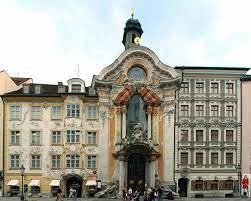
Pd: el trabajo es grupo fue algo tardado, supongo que por el hecho de que todos nos encontrabamos ocupados por las entregas finales. Pero logramos compenetrar y terminar a tiempo. Mi compañero masculino, se incorporo un poco tarde al grupo pero igual tratamos de que tuviera algo para exponer, fue corto, pero no quedo por fuera.
5 notes
·
View notes
Photo

Chiesa di San Carlino alle Quattro Fontane, 1646 by Francesco Borromini Surprisingly bold in architecture for the 17th century, this little church is Borromini's masterpiece. A complex plan with great fluidity of lines cleverly combines the geometries of the ellipse, the octagon, and the cross. Uniting architecture and sculpture, Borromini has created a harmonious interior, topped with an elegant dome. #IlikeItaly #Italy #Roma #Rome #VisitRome #igersitalia #IgersRoma #RaccontandoRoma #ChiesadiSanCarlinoalleQuattroFontane #FrancescoBorromini (at San Carlo alle Quattro Fontane) https://www.instagram.com/p/Cmo5-whLoZY/?igshid=NGJjMDIxMWI=
#ilikeitaly#italy#roma#rome#visitrome#igersitalia#igersroma#raccontandoroma#chiesadisancarlinoallequattrofontane#francescoborromini
2 notes
·
View notes
Text
La Reggia di Caserta: un gioiello del Barocco italiano
La Reggia di Caserta, situata nell'omonima città campana, è un imponente complesso monumentale che rappresenta uno dei capolavori indiscussi dell'architettura barocca in Italia. Voluta da Carlo di Borbone, re di Napoli e Sicilia, come residenza reale alternativa alla caotica Napoli, la sua costruzione ebbe inizio nel 1752 sotto la direzione del celebre architetto Luigi Vanvitelli.
Reggia di Caserta: l'immenso patrimonio storico
Il Palazzo, che si estende su una superficie di circa 47.000 metri quadrati, è caratterizzato da una pianta rettangolare articolata su quattro cortili interni. La sua facciata monumentale, lunga oltre 200 metri, colpisce per la sua armonia e il sapiente uso di elementi decorativi, come lesene, paraste e timpani. All'interno, la Reggia vanta oltre 1.200 stanze, riccamente decorate con affreschi, stucchi e sculture di pregio, opera di artisti rinomati come Francesco De Mura, Pietro Bianchi e Gaetano Callani.
Tra gli ambienti più suggestivi, si annoverano l'Appartamento Reale, con la sua Sala del Trono, la Cappella Palatina e la Biblioteca, e l'Appartamento Nuovo, dove spicca la Sala del Presepe con la sua straordinaria opera in miniatura. Degno di nota è anche il Teatro di Corte, considerato uno dei più belli d'Europa per la sua perfetta acustica e gli sfarzosi decori.
Il parco
Ma la vera perla della Reggia di Caserta è il suo immenso parco, che si estende per oltre 120 ettari. Ispirato alle grandi residenze reali europee, come Versailles e la Granja de San Ildefonso, il parco vanta una complessa articolazione di fontane, giochi d'acqua, statue, aiuole e boschetti, creando un'atmosfera di suggestiva bellezza. Tra i punti di maggior interesse, figurano la Cascata Grande, il Giardino Inglese, il Bosco Vecchio e la Peschiera.
La Reggia di Caserta, con il suo Palazzo, il parco e le numerose collezioni d'arte, è stata dichiarata Patrimonio dell'Umanità dall'UNESCO nel 1997. Oggi, questo complesso monumentale rappresenta una delle mete turistiche più ambite in Campania, attirando visitatori da tutto il mondo.
Foto di alex1965 da Pixabay
Read the full article
0 notes
Text
May 27- AAAAHHHH!!!!!!
When I read through the list of churches to present on before leaving… I absolutely jumped on Santa Maria Della Vittoria SO. FAST.
But that was the last place we went so, I’ll get to it. I’ll get to it.
Today was a big church day. Something about the “sexy wine” from the dinner the night before must’ve made me wake up at 7:30. Good thing Ella did too. Class at 8 and we have to make a 30 minute walk? Not happening. Luckily we hopped up and got going within fifteen minutes. It was insane how fast we ran through the streets to get to Il Gesù.
It’s always the first church that I think has weird energy. And it’s definitely because it’s early and usually there aren’t many people around. But I did like this church. We were in there for not that long, but me and another student were talking briefly with one of our professors about the theatricality of the ceiling here and baroque art, and “respecting the craft”.
The next church we stopped at was San Luigi dei Francese. This church has three Caravaggio paintings about Saint Matthew. I looove Caravaggio. He hits all the notes for me. I love an unhinged punky man doing his thing and doing it well. Getting to see his works in person have been a definite highlight of this trip.
I also really enjoyed the Caravaggio [Pilgrim’s Madonna, 1604] that was in the Sant’Agostino. Unfortunately and unsurprisingly, the Trevi Fountain was so busy and also being cleaned. So I will look at it better at an earlier time and different day. Also unfortunately and unsurprisingly, the San Andrea al Quirinale was not open either so that was off the menu too.
Nearing the end of our class day, we popped into San Carlo alle Quattro Fontane which was smaller than I expected. It was beautiful and super… delicate? Yet extremely expressive and also had super weird stairs and interestingly designed open space.
Then… my church. I’ve been excited the whole time to see this and truly have no excuse as to why I didn’t go before this day (Rome has been difficult in ways I can’t verbalize) but I was so so so excited to see Bernini’s Ecstasy of Saint Theresa. There’s just something so special about her personal account that pulls me in to it and to see this marble recreation of what Bernini would visualize for her just tickles something in my brain that nothing else can. It is so god damn gorgeous, I want to steal it. But I can’t without taking the whole chapel with me. They all work together too well to separate. But oh my god I need to look at this every day.
Anywho… rest of the day was chill. I went with a group of girls back to the UNIQLO store and then to dinner. I ate a pizza with a ton of tomato sauce (of course I didn’t know it was going to have an entire jar on it….) so everyone should be proud of me. Or don’t because I’m a baby and ate it with like only 10 complaints. So maybe everyone should be proud of me for not complaining 11 times. A win is a win.
In order:
1. Ceiling in Il Gesù. Sooooo theatrical.
2. Caravaggio’s The Calling of Saint Matthew, 1599-1600
3. The ceiling in San Carlo alle Quattro Fontane
4. Weird stairs
5. AAAAHHHHH!!!!!
6. Giant Calico Critters at the toy store next to the UNIQLO… why were we in a toy store? Why not? We live a little. We look a little. We love a lot.
7. Big fluffy dog in the UNIQLO store awww



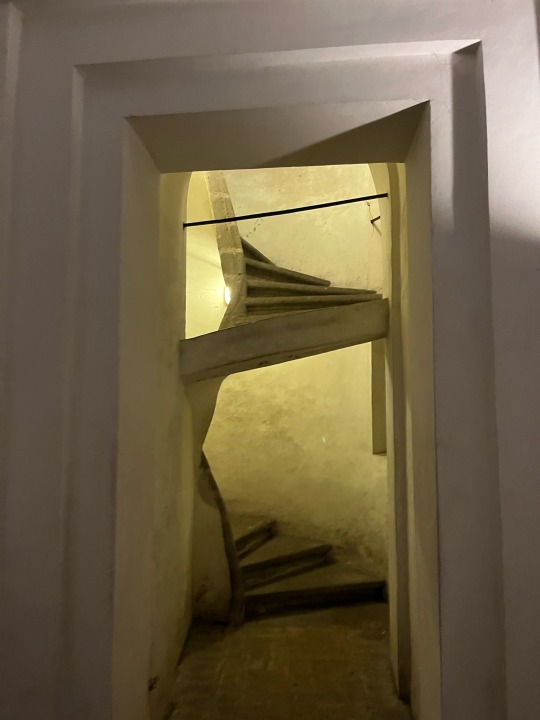
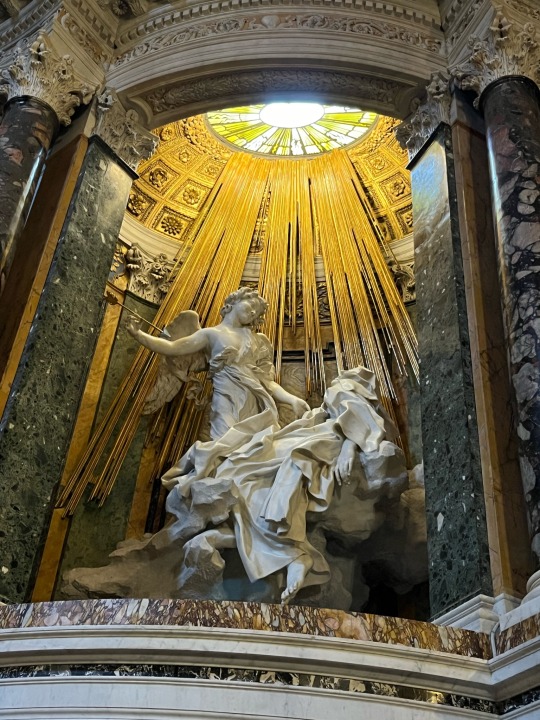


0 notes
Text
“Serra's most known series of sculpture using rolled steel plates are the Torqued Ellipses. In 1991 Serra visited Borromini's Church of San Carlo alle Quattro Fontane in Rome and mistook the ovals of the dome and the floor to be offset from one another.[58] He thought to make a sculpture in this torqued form. Serra constructed models of this perceived form in his studio by cutting two ellipse-shaped pieces of wood and nailing a dowel between them. He then turned the ellipses so they were at a right angle to one another and wrapped a sheet of lead around the form. After making a template from the models Serra worked with an engineer to fabricate the sculptures.[59] In total there are seven Torqued Ellipses and four Double Torqued Ellipses (an ellipse inside of an ellipse) dated between 1996 and 2004.[60] Each sculpture has a different degree or torque and measures up to 13 feet (3.9 m) high. The sculptures all have an opening so that they can be walked through and around.[61] Three Torqued Ellipses are on permanent view at Dia Beacon, New York.[62]”
0 notes
Text
La Arquitectura Barroca. "Iglesia de San Carlo alle Quattro Fontane" (Lacio, Roma). (1634-1668 d.C)

-Historia
La iglesia, el claustro y el monasterio fueron construidos entre 1634 y 1644 por Francesco Borromini, sobrino de Carlo Maderno. Este arquitecto suizo, que llegó a Roma en torno a 1620 desde el Cantón de Ticino, había colaborado anteriormente en el Baldaquino de San Pedro y en el cercano Palacio Barberini. Los Trinitarios le encargaron un nuevo convento e iglesia, donde había ya una pequeña capilla. El claustro, primera parte diseñada en el conjunto, fue proyectado por Borromini en 1635, pero se terminó en 1644, mientras que en el mismo año se terminó la fachada del Instituto sobre la actual Via del Quirinale (entonces llamada Strada Pia), la iglesia (que se comenzó en 1638) y un primer campanario adyacente de planta cuadrada.
La fachada de la iglesia fue diseñada y construida mucho más tarde, a partir de 1664. Después de la muerte del arquitecto en 1667, el trabajo fue continuado desde 1670 a 1680 por su sobrino Bernardo Borromini a partir de los dibujos del maestro. El campanario fue demolido para la prolongación del cuerpo convexo de la iglesia hacia la esquina de las Quattro Fontane, y se construyó uno nuevo en 1670. La decoración de la fachada se prolongó durante una década, hasta la instalación de la estatua de San Carlo en el nicho principal en 1680.
Hoy tenemos muchos planos alternativos de la iglesia, que Borromini había pensado para encontrar una solución que se ajustase a dos necesidades importantes: el costo más bajo posible, ya que los hermanos no tenían mucho dinero, y el uso eficiente del espacio disponible.

-¿El propósito del porqué elegí esta estructura?
La iglesia San Carlo alle Quattro Fontane, no solo es una de las obras más interesantes de Borromini a desarrollado, por su distribución de planta y como organiza el espacio si no que en este edificio llega a un ponto d compresión más matemático del barroco con una brillantez analítica remarcable. Apoyándose así con las líneas curvas y una geometría bien definida y elaborada, realzan todos los aspectos del proyecto donde la calidad espacial se sobrepone a lo limitado de su dimensión.
-Bibliografía de dónde se extrajo el contenido y sirvió de apoyo
1 note
·
View note
Text
Parcial III - San Juan de Nepomuceno

La iglesia de San Juan de Nepomuceno ubicada en Múnich, es una obra representativa del barroco tardío o Rococo, diseñado por los hermanos Asam como su capilla privada.
Esta obra cuenta con una fachada bastante sobria en relación al interior, lo más llamativo de esta es el pórtico de acceso el cual posee una amplia similitud con la obra estudiada con anterioridad San Carlo Alle Quattro Fontane, y este se corona con una amplia escultura del santo San Juan de Nepomuceno. En el interior, la ornamentación toma la jerarquia del espacio, este se encuentra divido en 3 naves: la central y las laterales. El presbiterio está enmarcado por 4 columnas salomónicas cuya referencia es el Baldaquino de San Pedro. La iglesia cuenta con una planta de cruz latina y una amplia cúpula alargada cuyo fresco es pintado por Cosme Damian, tambien arquitecto de la obra.
Me quedo de esta obra, con el trabajo de iluminación, se puede ver claramente como esta se gradúa a medida que se mira hacia arriba, causando una sensación de ascensión. La luz está dispuesta que asocie la parte baja de la edificación con la sociedad o lo mundano y a medida que sube al cielo la iluminación se hace mayor, esto como referencia a la cercanía con Dios.
@lonuevodenuevo
0 notes